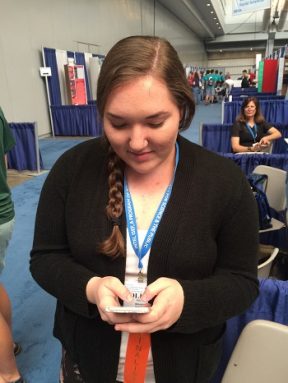Hands-free but still distracted
Even hands-free devices slow our reaction times, Intel ISEF finalist Olivia Brown finds

When we are focused, we see a traffic light change almost instantly. But while texting, or even using a hands-free device, it’s a different matter, new data show.
Horia Varlan/Flickr (CC BY 2.0)
PITTSBURGH, Pa. — By now, most of us know it’s not safe to text and drive. But many people assume that dictating your message using a hands-free device is safer. A high school student tested that assumption — and found it’s false. Whether we type with our thumbs or talk into our phones, our reaction times will still become dangerously slow.
Olivia Brown, 16, of Springfield, Mo., presented new findings here, this week, at the Intel International Science and Engineering Fair. Created by Society for Science & the Public and sponsored by Intel, this event brings young scientists together from around the world to show off their science projects. (SSP also publishes Science News for Students and this blog).

But the teen also had heard that driving with a hands-free device was safer. Hoping to calm her fears, she decided to test that claim.
Olivia recruited 100 high school and college students. Each volunteer sat in a room with a light bulb that would change randomly from red to green. This simulated a traffic light changing. When they saw the color change, the students had to hit a button as fast as they could. The volunteers did the task three times. Once they had no distractions. Another time, they were composing a text message with their fingers on a smartphone. A third time they were composing a text message on their phone by speaking into a hands-free device. Each time, Olivia recorded how long it took the students to notice the light color had changed.
Unfortunately, the results did not calm Olivia’s fears. The students reacted quickly when they were not distracted. But both texting and speaking into the hands-free device meant that the students reacted more slowly to the light’s changing color. The hands-free device was just no better than holding the phone while texting.
“Having no distractions is by far the safest,” Olivia says. Texting, hands-free device or not, definitely makes drivers slower. Now, the teen wants to test other distractions, such as listening to music and chatting with people in the car. But her findings aren’t making her less nervous about getting behind the wheel.
Follow Eureka! Lab on Twitter
Power Words
(for more about Power Words, click here)
smartphone A cell (or mobile) phone that can perform a host of functions, including search for information on the Internet.
Society for Science and the Public (or SSP) A nonprofit organization created in 1921 and based in Washington, D.C. Since its founding, SSP has been not only promoting public engagement in scientific research but also the public understanding of science. It created and continues to run three renowned science competitions: The Intel Science Talent Search (begun in 1942), the Intel International Science and Engineering Fair (initially launched in 1950) and Broadcom MASTERS (created in 2010). SSP also publishes award-winning journalism: in Science News (launched in 1922) and Science News for Students (created in 2003). Those magazines also host a series of blogs (including Eureka! Lab).







